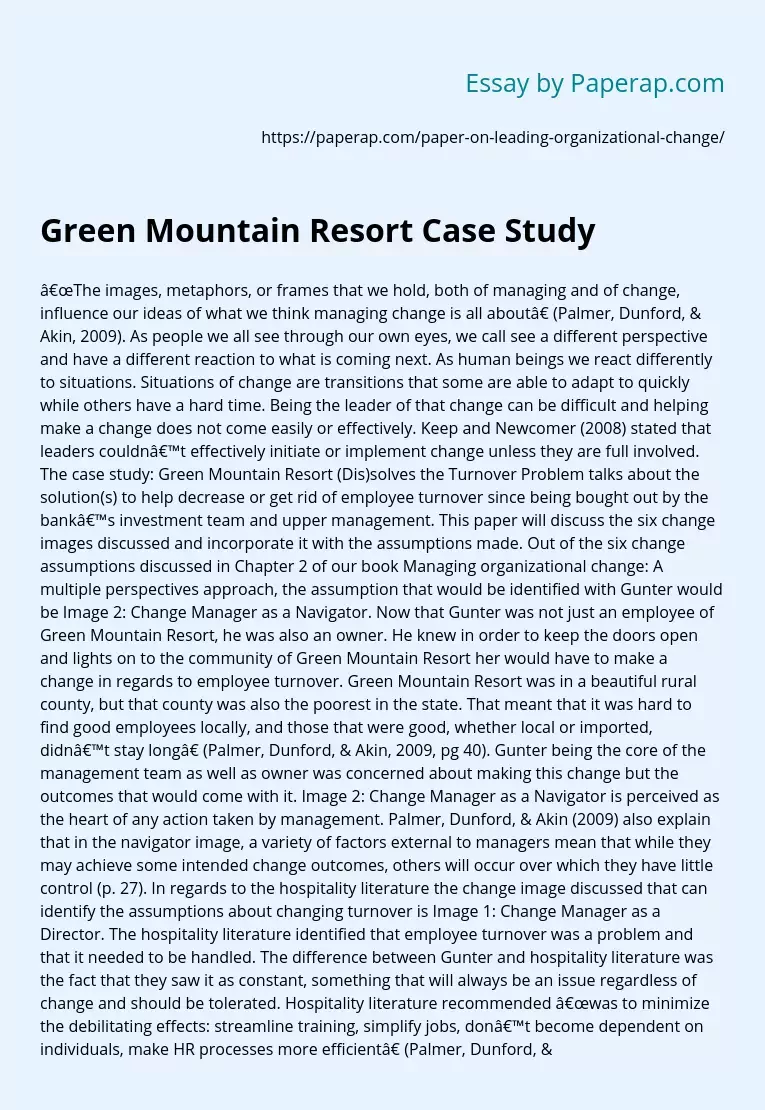Green Mountain Resort Case Study
“The images, metaphors, or frames that we hold, both of managing and of change, influence our ideas of what we think managing change is all about” (Palmer, Dunford, & Akin, 2009). As people we all see through our own eyes, we call see a different perspective and have a different reaction to what is coming next. As human beings we react differently to situations. Situations of change are transitions that some are able to adapt to quickly while others have a hard time.
Being the leader of that change can be difficult and helping make a change does not come easily or effectively. Keep and Newcomer (2008) stated that leaders couldn’t effectively initiate or implement change unless they are full involved. The case study: Green Mountain Resort (Dis)solves the Turnover Problem talks about the solution(s) to help decrease or get rid of employee turnover since being bought out by the bank’s investment team and upper management. This paper will discuss the six change images discussed and incorporate it with the assumptions made.
Out of the six change assumptions discussed in Chapter 2 of our book Managing organizational change: A multiple perspectives approach, the assumption that would be identified with Gunter would be Image 2: Change Manager as a Navigator. Now that Gunter was not just an employee of Green Mountain Resort, he was also an owner. He knew in order to keep the doors open and lights on to the community of Green Mountain Resort her would have to make a change in regards to employee turnover.
Green Mountain Resort was in a beautiful rural county, but that county was also the poorest in the state.
That meant that it was hard to find good employees locally, and those that were good, whether local or imported, didn’t stay long” (Palmer, Dunford, & Akin, 2009, pg 40). Gunter being the core of the management team as well as owner was concerned about making this change but the outcomes that would come with it. Image 2: Change Manager as a Navigator is perceived as the heart of any action taken by management.
Palmer, Dunford, & Akin (2009) also explain that in the navigator image, a variety of factors external to managers mean that while they may achieve some intended change outcomes, others will occur over which they have little control (p. 27). In regards to the hospitality literature the change image discussed that can identify the assumptions about changing turnover is Image 1: Change Manager as a Director. The hospitality literature identified that employee turnover was a problem and that it needed to be handled.
The difference between Gunter and hospitality literature was the fact that they saw it as constant, something that will always be an issue regardless of change and should be tolerated. Hospitality literature recommended “was to minimize the debilitating effects: streamline training, simplify jobs, don’t become dependent on individuals, make HR processes more efficient” (Palmer, Dunford, & Akin, 2009, p. 41). The director image is based that results of change is reachable and management needs to be able to take control of making this change.
Lastly the change image associated with the consultant would be Image 5: Change Manager as an Interpreter. “The interpreter image to managing change places the change manager in the position of creating meaning for other organizational members, helping them to make sense of various organizational events and actions” (Palmer, Dunford, & Akin, 2009, p. 31). Instead of coming up with way to solve the problem of high turnover, the consultant helped Gunter see the problem in a different perspective by using it to benefit the organization vs. hurting it.
The three change images discussed could all help with influencing assumptions about a recommendation to help with “the turnover problem. Gunter could have just took full action and made changes that he thought would benefit the organization or even take the approach of the hospitality literature and be direct with the change as other companies have probably done in the past. The change Image the consultant took was definitely the most beneficial by helping Gunter interpreter a new type of change by using the high turnover to the company’s advantage.
Another change image that could have been used to help Green Mountain Resort with the high turnover could have been Image 4: Change Managers as a Coach. Gunter could have help deliberately mold the organization’s natural ability in specific ways. “Rather than dictating the exact state of each play as the director might attempt to do, the coach relies upon building in the right set of values, skills, and “drills” that are deemed to be the best ones that organizational members, as players, will be able to draw on adeptly in order o achieve desired organizational outcomes” (Palmer, Dunford, & Akin, 2009, p. 30).
In conclusion, the statement at the start of the chapter that “if we only draw upon one particular frame, then this will take us away from thinking about what is going on from an alternative perspective” reminds us as manager leading change in an organization to not just jump to the first idea on how to make change.
We need to be able to think outside the box and make a change in how we react to change and what are first instincts of action would be. Having different perspectives in how to go about change will allow managers to really engage and figure out what the best plan of action will be. “Changes often fail because leadership fails to fully understand or underestimates the complexity of the change, increasing the risk that the change will not yield the desired results”(Keep & Newcomer, 2008).
Green Mountain Resort Case Study. (2017, May 27). Retrieved from https://paperap.com/paper-on-leading-organizational-change/

